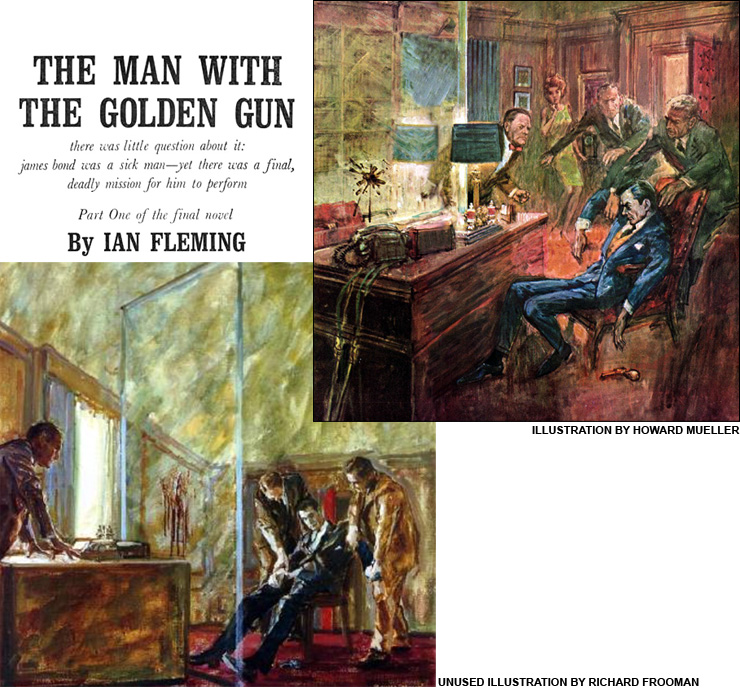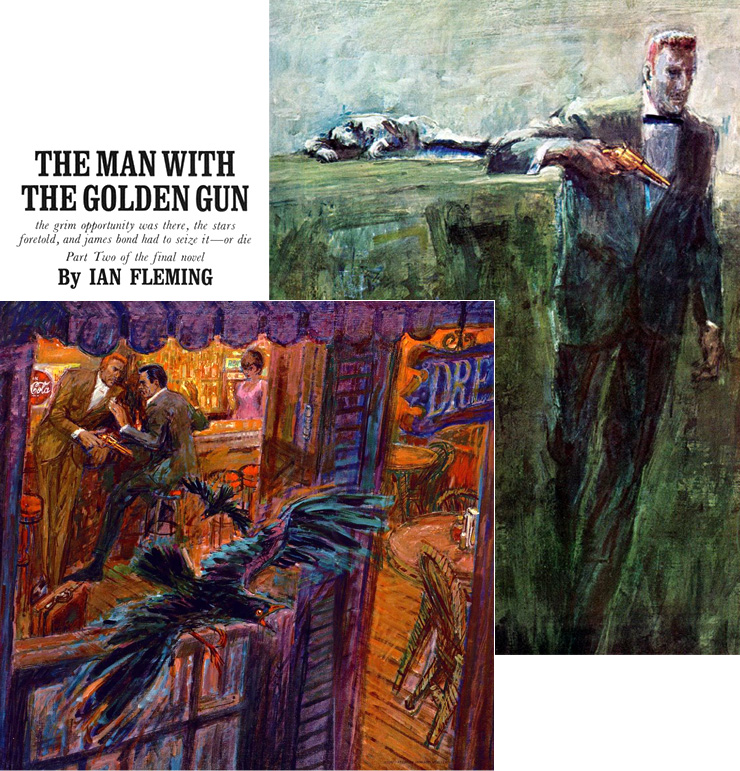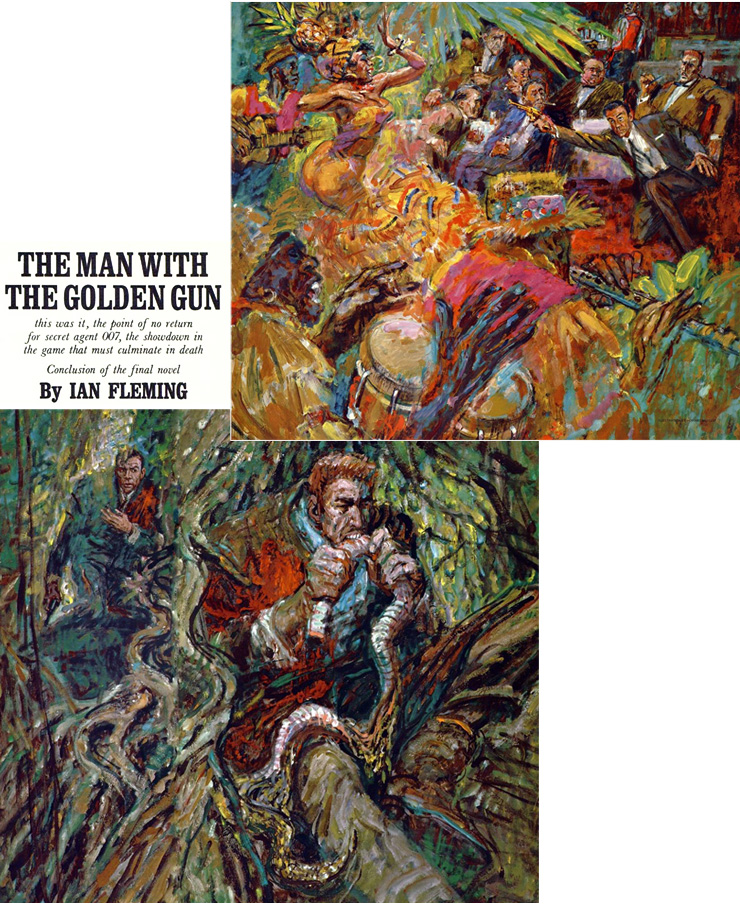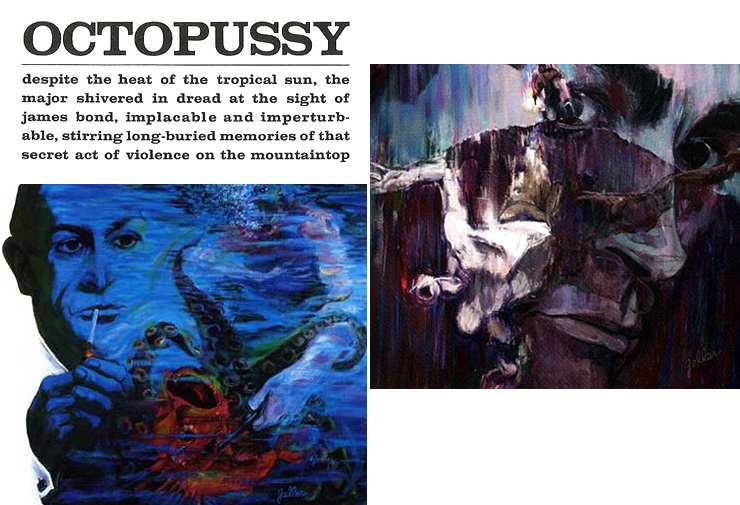|
|
JAMES BOND
|
|
|
JAMES BOND
|
|
|||||||
|
|||||||
|
Shortly before Ian Fleming's fatal heart attack in 1964 he wrote a letter to PLAYBOY: “Please be sure that PLAYBOY will, as previously, receive preferential treatment from my pen, and for your ears only, I recently turned down an offer from [here Fleming named another American magazine] for the serialization of my next book on the grounds I felt morally committed to you...”. The next book was THE MAN WITH THE GOLDEN GUN, the manuscript for which had been revised by his publisher Jonathan Cape prior to its release in the UK on April 1, 1965. The same month PLAYBOY began a four-part serialization of the novel ahead of its US publication in August 1965 by the New American Library. Five illustrations by Howard Mueller (1900-1990) accompanied the PLAYBOY serialization. The opening instalment featured the aftermath of Bond's attempted assassination of M in his London office. This scene was originally illustrated by Richard Frooman, who had earlier provided stylish artwork for THE PROPERTY OF A LADY in the January 1964 issue of PLAYBOY. The characters of Bond and M in the finished Howard Mueller illustration look as if they were clearly based on actors Sean Connery and Bernard Lee. Perhaps this is why Mueller was chosen above Frooman to illustrate the story. |
|||||||
 |
|||||||
|
The second full-page illustration in the April 1965 issue was a superb depiction of Francisco Scaramanga (below right) showing why he was called ‘The Man With The Golden Gun’. May 1965 saw Scaramanga demonstrating his prowess to James Bond (in the guise of Mark Hazard) in a Jamaican bar; whilst the June 1965 instalment saw Bond returning the favour as he shoots a pineapple off a dancer's head with Scaramanga's golden gun. The June 1965 issue of PLAYBOY also contains a pictorial featuring the original Bond girl Ursula Andress in an exclusive photoshoot by her husband John Derek. |
|||||||
 |
|||||||
|
The concluding instalment of THE MAN WITH THE GOLDEN GUN appeared in the July 1965 issue of PLAYBOY accompanied by Howard Mueller's illustration (spread across two pages in the printed issue) depicting a wounded Bond watching Scaramanga bite into the body of a snake during their confrontation in the Jamaican swampland at the climax of the story. The original artwork (along with Mueller's first piece from the April 1965 issue) sold for $7,170 in 2003 at the CHRISTIE'S ‘PLAYBOY at 50’ auction. |
|||||||
 |
|||||||
|
PLAYBOY commended Chicago-born artist Howard Mueller for his compelling illustrations which perfectly captured Sean Connery's craggy likeness in all four instalments of THE MAN WITH THE GOLDEN GUN. Although PLAYBOY's review of the first James Bond film Dr. No in the May 1963 issue was less than enthusiastic, the magazine was keen to capitalise on the success of the films now that there was no more new Ian Fleming material left to publish. |
|||||||
|
|
|||||||
|
Perhaps the most collectible of all issues of PLAYBOY is the November 1965 edition which appeared at the height of ‘Bondmania’, just before the release of Thunderball, the fourth film in the hugely successful series. Featuring a lengthy and candid interview with Sean Connery, the magazine sported an iconic cover of Playgirl Beth Hyatt by celebrated Italian Photographer Pompeo Posar (1921-2004). A 14-page pictorial essay by screenwriter Richard Maibaum entitled “James Bond's Girls” featuring Ursula Andress, Daniela Bianchi, Nadja Regin, Tania Mallet, Lois Maxwell, Margaret Nolan, Shirley Eaton, Honor Blackman, Maggie Wright, Claudine Auger, Luciana Paluzzi, Martine Beswicke and Molly Peters. Many of the Bond Girls featured in the pictorial were photographed by Donald Silverstein (1934-1975). The New York based London-born photographer would later go on to immortalise rock star Jimi Hendrix in an iconic 1967 photo-shoot. His Bond Girl photographs would be recycled in later editions of PLAYBOY (often flipped, or cropped, and sometimes full-page) or substituted with alternate versions from the same sessions. Silverstein went uncredited in the November 1965 issue of PLAYBOY. In addition to those actresses listed above, Michel Mok and Yvonne Shima (Sister Rose and Sister Lily in Dr. No) were also photographed in costume for the November 1965 issue, but the image went unpublished. |
|||||||
|
|||||||
|
Following the success of the posthumous release of THE MAN WITH THE GOLDEN GUN in 1965, the public were clamouring for more James Bond. In 1962 Ian Fleming had written a short story entitled OCTOPUSSY, which was later serialized in the Daily Express (with illustrations by Andrew Robb) from 4 -8 October 1965. Jonathan Cape published OCTOPUSSY AND THE LIVING DAYLIGHTS in hardback on June 23, 1966 in the UK (the US edition was published at the same time by the New American Library and simply bore the title OCTOPUSSY). THE LIVING DAYLIGHTS was a short story commissioned for The Sunday Times and originally appeared in the newspaper's Sunday supplement on February 4, 1962. |
|||||||
 |
|||||||
|
Prior to its hardback publication, OCTOPUSSY first appeared in the United States in the March and April 1966 issues of PLAYBOY, accompanied by illustrations by Barry Geller (1932-2010). Once again the artist used Sean Connery's likeness in his illustrations - at the time no other face could depict James Bond in the eyes of the reader! OCTOPUSSY was the last James Bond story serialized in PLAYBOY until 1997. Barry Geller's original art for the April 1966 issue was sold at the ‘PLAYBOY at 50’ auction in 2003 for $4,541. |
|||||||
|
|||||||